|
Sub-problem 2d - Page 2 of 2 |
ID# C102D02 |
Sub-problem 2d:
Effects of a Signal on an Existing Coordinated System
Finding the optimal common cycle length can be achieved by
using any of several traffic models that take all of the
previously-identified factors into
consideration. The HCM, however, does not include a methodology that can be
used to make this determination. For the purposes of this discussion we will choose a 90-second
cycle; this choice will accommodate a progression band through the
intersections that is no smaller than the shortest arterial green phase,
which, in this case is found at SH 8.
Now, if we extend the time–space diagram (see Exhibit 1-26) to include the new intersection at Styner-Lauder, we can determine the effect of a signal at this intersection
on the entire coordinated system. Note that the distance to Styner-Lauder
dictates an alternating relationship between the green phases with the
adjacent intersection. Similarly, the close spacing of the SH 8 and Sweet
intersections dictates a more-or-less simultaneous green phase strategy for
the through movements. The simple two-phase operation at Styner-Lauder
provides a longer green phase on the arterial (NB and SB approaches), so the additional signal is
able to fit into the progression scheme without encroaching into the bands
of progression that currently exist between the two signals.
The conclusion
that we can draw from this is that it is possible to signalize the Styner-Lauder intersection without a significant adverse effect on the
driver-perceived progression, even though the arterial street analysis
conducted in subproblem 2c
suggests that travel speed
will be impacted by 13 percent.
Exhibit 1-26. Signal Coordination Time/Space Diagram

[ Back ] [
Continue ] to
Problem 2 Analysis
